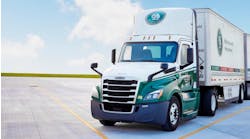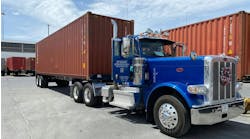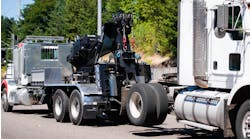It’s the spookiest time of year. The time that marks the end of the harvest and the beginning of a dark, cold winter. And this year, the economic backdrop here at home and across the globe is quite daunting.
Fuel prices are at record highs, some areas of the world are worried about grain and food supply shortages amid Russia’s ongoing war with Ukraine, and fuel uncertainty in some European countries has people frightened they may have limited natural gas to heat their homes this winter.
Here in the U.S., inflation has hit a 40-year high of more than 8%. On the other hand, analysts predict inflation will slow down to about 4% next year; however, 4% is still too high, Lee A. Klaskow, senior freight transportation and logistics analyst at Bloomberg Intelligence, told attendees during a session on managing cashflow at the American Trucking Associations’ Management Conference & Exhibition in San Diego on Oct. 24.
“We’ve been living with anywhere from 1-3%,” Klaskow said of more traditional inflation rates. “The outlook for the economy is not fantastic.”
“We are not in a recession now,” he added, noting the chance of a recession in the U.S. is about 60% compared to Europe’s 80%. “At the end of the day, there is a true chance that the U.S. is going to be in a recession. I believe any recession the U.S. has will be short and shallow.”See also: As recession concerns rise, driver shortage figures stall
Industry analysts and financial experts Steve Smith, senior industry adviser at DDC FPO and president of Smith Transportation Consulting Services; Chris Henry, COO of KSMTA Canada; and Zack King, former EVP and CFO of USA Truck, which was recently acquired by DB Schenker, joined Klaskow to break down some ways fleets can better manage their cashflow in today’s volatile environment. Here are some highlights from that session.
How culture can drive cashflow management
As a consultant, Henry typically works with carriers that have between 50 and 300 trucks. Early on, he learned there is very little transparency from the C-suite down to the frontlines of most trucking companies.
Frontline workers "don’t really know how well or how poor the company is doing in all these different freight environments,” Henry said. “But [carriers] who were very transparent tended to have a lot better performance in the long term.”
To keep operations more transparent, when King was at USA Truck, he said one initiative the carrier instituted in 2019 was training all company employees—from drivers to back-office staff—on how their individual roles affect the company's overall cashflow.
“The biggest thing I’ve noticed is that when times get tight and people know what the plan is and when you stick to the plan, it will come through,” Smith added. “You can’t cut your way to profitability. You have to have a plan, follow the plan, and teach your people what that plan is.”
Smith also emphasized the importance of growing while controlling costs as well as for fleets to understand their days sales outstanding (DSO) numbers.
“If you don’t know, you can’t fix it,” he added. “You have to know what your revenue is. If you can cut your DSO by two days, how much more cash does that give you to do the things you need to do? If you’re a $150 million company and you do $3 million a week, if you can cut two days out of your DSO, you have $1.2 million in cash that you have more readily available to do things with.”
Analyze lanes, invest in training
Analysts also stressed the need for fleets to invest in their sales force, put money into training, and thoroughly evaluate their networks to pursue the lanes that benefit their business operations.
KSMTA, Henry noted, performs assessments of each carrier’s network and evaluates every load and every lane, analyzing revenue, cost, and time.
Smith, pointing out his company was a KSMTA customer 10 years ago, noted the firm helped his trucking company determine where they had limited capacity and which lanes weren’t good to pursue.
“It allowed us to identify those lanes and go back to our customers and say, ‘I’ll give you capacity, but I would really like to give you these five lanes back,’” Smith said. “Once you have that information, they’ll buy in because all they want is capacity.”
King agreed that it’s about pursuing the right lanes and making a series of small changes.
“You can’t go to a customer and say, ‘I want to give back all these lanes that I have and want these that are better for me,’” King noted. “It’s a progression over time. To get our network to where it is today, it was a three-year process. Your network constantly changes, and you constantly have to evaluate where your driver is, where your base is, where your terminals are, and formulate that based on where your customers are.”
Strategically invest in equipment and people
When the economy starts to slow down, the industry’s kneejerk reaction is to extend the life of equipment, Smith noted. However, extending the life of a tractor could help fleets save capital in the short term, but eliminate cashflow due to the cost of repairs.
“Always get current with your trade cycle,” Smith advised. “With a tractor, let’s call it five years, but it really depends on your business and how many years you are going to drive. If you’re not a big business, you cannot get off your set plan. If you have a plan that works for you, don’t deviate. You will go down a maintenance and repair hole very quickly if you try to extend tractor lifecycles.”
King added that fleets should not stop investing in new equipment because it makes drivers happy. He added that technology investments are also important to help make employees' jobs more efficient.
And when it comes to driver recruiting, costs are high, but worthwhile.
“When I was at USA Truck, one of the main things that we saw the largest jump in with our driver recruitment went back to the culture,” King said. “Changing the culture of USA Truck and how we approached the market, treated our drivers, and how we serviced our customers, it became a better place to work. We saw our costs rise for recruitment.”
“If you don’t have a driver referral program in place, that is something I would encourage you to look at,” King added. “We have a driver referral program that will pay a bonus to that driver if they recruit someone that they meet at a truck stop. With the change in culture, it got to the point when our drivers were referring 50% of the drivers in the company.”
Henry noted that the cost to replace a driver today can be upwards of $23,000. Smith also urged fleets to invest in training and retaining technicians.
“Finding a good mechanic today is harder than finding a driver,” he said, adding a fleet can triple its costs by outsourcing maintenance.
At the end of the day, Smith said, it’s not so much how much cash fleets have in the bank it’s the cash available to them—meaning liquidity. He also advised fleets not to hoard cash if they have items on their to-do list that need to get done.
“Whether it’s replenishing your fleet or updating your training cycle, spend the cash now if it’s capital,” Smith urged. “If you have the technology and you’re two-thirds of the way in, don’t hoard your cash, finish the project. If you’re building a new facility, don’t stop that, finish it, and use that cash today.”





